vue3 对 vue2 有什么优势
- 性能更好(编译优化、使用
proxy等) - 体积更小
- 更好的
TS支持 - 更好的代码组织
- 更好的逻辑抽离
- 更多新功能
vue3 和 vue2 的生命周期有什么区别
Options API生命周期
beforeDestroy改为beforeUnmountdestroyed改为umounted- 其他沿用
vue2生命周期
Composition API生命周期
import { onBeforeMount, onMounted, onBeforeUpdate, onUpdated, onBeforeUnmount, onUnmounted } from 'vue'
export default {
name: 'LifeCycles',
props: {
msg: String
},
// setup等于 beforeCreate 和 created
setup() {
console.log('setup')
onBeforeMount(() => {
console.log('onBeforeMount')
})
onMounted(() => {
console.log('onMounted')
})
onBeforeUpdate(() => {
console.log('onBeforeUpdate')
})
onUpdated(() => {
console.log('onUpdated')
})
onBeforeUnmount(() => {
console.log('onBeforeUnmount')
})
onUnmounted(() => {
console.log('onUnmounted')
})
},
// 兼容vue2生命周期 options API和composition API生命周期二选一
beforeCreate() {
console.log('beforeCreate')
},
created() {
console.log('created')
},
beforeMount() {
console.log('beforeMount')
},
mounted() {
console.log('mounted')
},
beforeUpdate() {
console.log('beforeUpdate')
},
updated() {
console.log('updated')
},
// beforeDestroy 改名
beforeUnmount() {
console.log('beforeUnmount')
},
// destroyed 改名
unmounted() {
console.log('unmounted')
}
}
如何理解Composition API和Options API
composition API对比Option API
-
Composition API带来了什么
- 更好的代码组织
- 更好的逻辑复用
- 更好的类型推导
-
Composition API和Options API如何选择
- 不建议共用,会引起混乱
- 小型项目、业务逻辑简单,用
Option API成本更小一些 - 中大型项目、逻辑复杂,用
Composition API
ref如何使用
ref
- 生成值类型的响应式数据
- 可用于模板和
reactive - 通过
.value修改值
<template>
<p>ref demo {{ageRef}} {{state.name}}</p>
</template>
<script>
import { ref, reactive } from 'vue'
export default {
name: 'Ref',
setup() {
const ageRef = ref(20) // 值类型 响应式
const nameRef = ref('test')
const state = reactive({
name: nameRef
})
setTimeout(() => {
console.log('ageRef', ageRef.value)
ageRef.value = 25 // .value 修改值
nameRef.value = 'testA'
}, 1500);
return {
ageRef,
state
}
}
}
</script>
<!-- ref获取dom节点 -->
<template>
<p ref="elemRef">我是一行文字</p>
</template>
<script>
import { ref, onMounted } from 'vue'
export default {
name: 'RefTemplate',
setup() {
const elemRef = ref(null)
onMounted(() => {
console.log('ref template', elemRef.value.innerHTML, elemRef.value)
})
return {
elemRef
}
}
}
</script>
toRef和toRefs如何使用和最佳方式
toRef
- 针对一个响应式对象(
reactive封装的)的一个属性,创建一个ref,具有响应式 - 两者保持引用关系
toRefs
- 将响应式对象(
reactive封装的)转化为普通对象 - 对象的每个属性都是对象的
ref - 两者保持引用关系
合成函数返回响应式对象
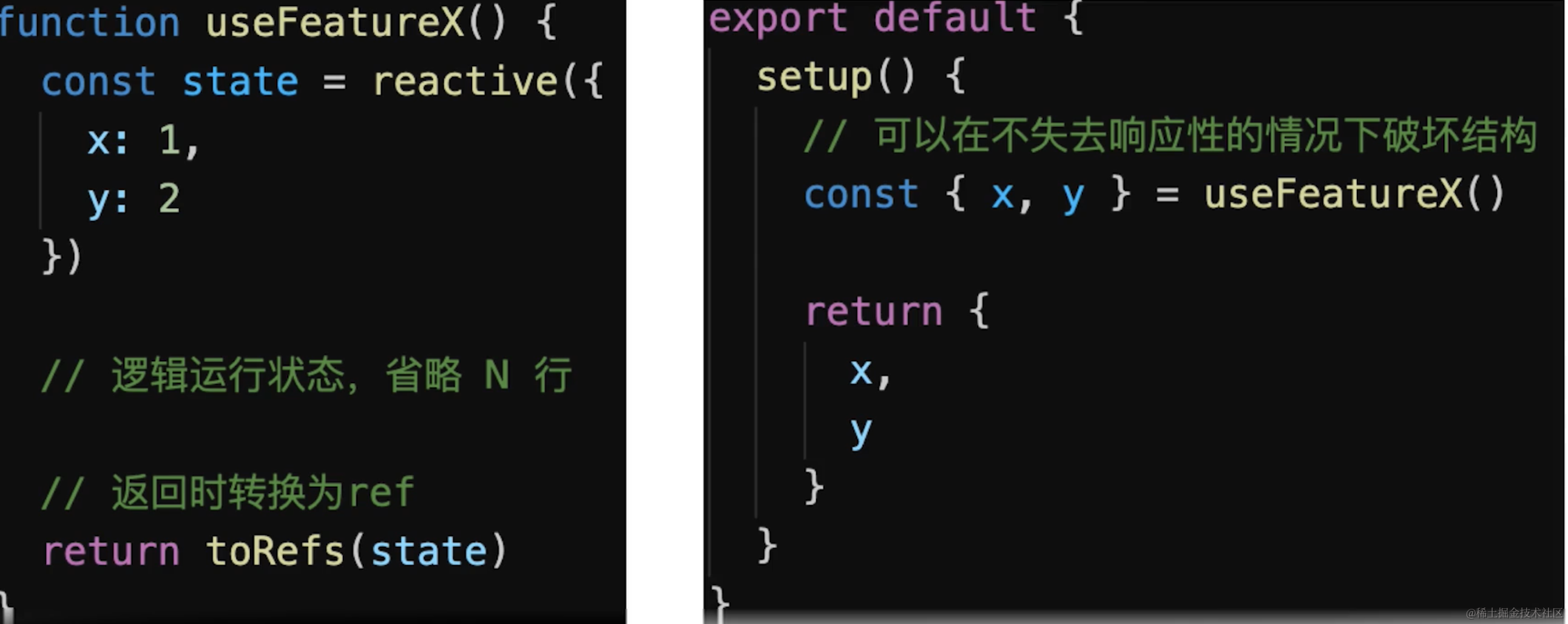
最佳使用方式
- 用
reactive做对象的响应式,用ref做值类型响应式(基本类型) setup中返回toRefs(state),或者toRef(state, 'prop')ref的变量命名都用xxRef- 合成函数返回响应式对象时,使用
toRefs,有助于使用方对数据进行解构时,不丢失响应式
<template>
<p>toRef demo - {{ageRef}} - {{state.name}} {{state.age}}</p>
</template>
<script>
import { ref, toRef, reactive } from 'vue'
export default {
name: 'ToRef',
setup() {
const state = reactive({
age: 20,
name: 'test'
})
const age1 = computed(() => {
return state.age + 1
})
// toRef 如果用于普通对象(非响应式对象),产出的结果不具备响应式
// const state = {
// age: 20,
// name: 'test'
// }
// 一个响应式对象state其中一个属性要单独拿出来实现响应式用toRef
const ageRef = toRef(state, 'age')
setTimeout(() => {
state.age = 25
}, 1500)
setTimeout(() => {
ageRef.value = 30 // .value 修改值
}, 3000)
return {
state,
ageRef
}
}
}
</script>
<template>
<p>toRefs demo {{age}} {{name}}</p>
</template>
<script>
import { ref, toRef, toRefs, reactive } from 'vue'
export default {
name: 'ToRefs',
setup() {
const state = reactive({
age: 20,
name: 'test'
})
const stateAsRefs = toRefs(state) // 将响应式对象,变成普通对象
// const { age: ageRef, name: nameRef } = stateAsRefs // 每个属性,都是 ref 对象
// return {
// ageRef,
// nameRef
// }
setTimeout(() => {
state.age = 25
}, 1500)
return stateAsRefs
}
}
</script>
深入理解为什么需要ref、toRef、toRefs
为什么需要用 ref
- 返回值类型,会丢失响应式
- 如在
setup、computed、合成函数,都有可能返回值类型 Vue如不定义ref,用户将制造ref,反而更混乱
为何ref需要.value属性
ref是一个对象(不丢失响应式),value存储值- 通过
.value属性的get和set实现响应式 - 用于模板、
reactive时,不需要.value,其他情况都要
为什么需要toRef和toRefs
- 初衷:不丢失响应式的情况下,把对象数据
分解/扩散 - 前端:针对的是响应式对象(
reactive封装的)非普通对象 - 注意:不创造响应式,而是延续响应式
<template>
<p>why ref demo {{state.age}} - {{age1}}</p>
</template>
<script>
import { ref, toRef, toRefs, reactive, computed } from 'vue'
function useFeatureX() {
const state = reactive({
x: 1,
y: 2
})
return toRefs(state)
}
export default {
name: 'WhyRef',
setup() {
// 解构不丢失响应式
const { x, y } = useFeatureX()
const state = reactive({
age: 20,
name: 'test'
})
// computed 返回的是一个类似于 ref 的对象,也有 .value
const age1 = computed(() => {
return state.age + 1
})
setTimeout(() => {
state.age = 25
}, 1500)
return {
state,
age1,
x,
y
}
}
}
</script>
vue3升级了哪些重要功能
1. createApp
// vue2
const app = new Vue({/**选项**/})
Vue.use(/****/)
Vue.mixin(/****/)
Vue.component(/****/)
Vue.directive(/****/)
// vue3
const app = createApp({/**选项**/})
app.use(/****/)
app.mixin(/****/)
app.component(/****/)
app.directive(/****/)
2. emits属性
// 父组件
<Hello :msg="msg" @onSayHello="sayHello">
// 子组件
export default {
name: 'Hello',
props: {
msg: String
},
emits: ['onSayHello'], // 声明emits
setup(props, {emit}) {
emit('onSayHello', 'aaa')
}
}
3. 多事件
<!-- 定义多个事件 -->
<button @click="one($event),two($event)">提交</button>
4. Fragment
<!-- vue2 -->
<template>
<div>
<h2>{{title}}</h2>
<p>test</p>
</div>
</template>
<!-- vue3:不在使用div节点包裹 -->
<template>
<h2>{{title}}</h2>
<p>test</p>
</template>
5. 移除.sync
<!-- vue2 -->
<MyComponent :title.sync="title" />
<!-- vue3 简写 -->
<MyComponent v-model:title="title" />
<!-- 非简写 -->
<MyComponent :title="title" @update:title="title = $event" />
.sync用法
父组件把属性给子组件,子组件修改了后还能同步到父组件中来
<template>
<button @click="close">关闭</button>
</template>
<script>
export default {
props: {
isVisible: {
type: Boolean,
default: false
}
},
methods: {
close () {
this.$emit('update:isVisible', false);
}
}
};
</script>
<!-- 父组件使用 -->
<chlid-component :isVisible.sync="isVisible"></chlid-component>
<text-doc :title="doc.title" @update:title="doc.title = $event"></text-doc>
<!-- 为了方便期间,为这种模式提供一个简写 .sync -->
<text-doc :title.sync="doc.title" />
6. 异步组件的写法
// vue2写法
new Vue({
components: {
'my-component': ()=>import('./my-component.vue')
}
})
// vue3写法
import {createApp, defineAsyncComponent} from 'vue'
export default {
components: {
AsyncComponent: defineAsyncComponent(()=>import('./AsyncComponent.vue'))
}
}
7. 移除filter
<!-- 以下filter在vue3中不可用了 -->
<!-- 在花括号中 -->
{message | capitalize}
<!-- 在v-bind中 -->
<div v-bind:id="rawId | formatId"></div>
8. Teleport
<button @click="modalOpen = true">
open
</button>
<!-- 通过teleport把弹窗放到body下 -->
<teleport to="body">
<div v-if="modalOpen" classs="modal">
<div>
teleport弹窗,父元素是body
<button @click="modalOpen = false">close</button>
</div>
</div>
</teleport>
9. Suspense
<Suspense>
<template>
<!-- 异步组件 -->
<Test1 />
</template>
<!-- fallback是一个具名插槽,即Suspense内部有两个slot,一个具名插槽fallback -->
<template #fallback>
loading...
</template>
</Suspense>
10. Composition API
reactiverefreadonlywatch和watchEffectsetup- 生命周期钩子函数
Composition API 如何实现逻辑复用
- 抽离逻辑代码到一个函数
- 函数命名约定为
useXx格式(React Hooks也是) - 在
setup中引用useXx函数
<template>
<p>mouse position {{x}} {{y}}</p>
</template>
<script>
import { reactive } from 'vue'
import useMousePosition from './useMousePosition'
// import useMousePosition2 from './useMousePosition'
export default {
name: 'MousePosition',
setup() {
const { x, y } = useMousePosition()
return {
x,
y
}
// const state = useMousePosition2()
// return {
// state
// }
}
}
</script>
import { reactive, ref, onMounted, onUnmounted } from 'vue'
function useMousePosition() {
const x = ref(0)
const y = ref(0)
function update(e) {
x.value = e.pageX
y.value = e.pageY
}
onMounted(() => {
console.log('useMousePosition mounted')
window.addEventListener('mousemove', update)
})
onUnmounted(() => {
console.log('useMousePosition unMounted')
window.removeEventListener('mousemove', update)
})
// 合成函数尽量返回ref或toRefs(state) state = reactive({})
// 这样在使用的时候可以解构但不丢失响应式
return {
x,
y
}
}
// function useMousePosition2() {
// const state = reactive({
// x: 0,
// y: 0
// })
// function update(e) {
// state.x = e.pageX
// state.y = e.pageY
// }
// onMounted(() => {
// console.log('useMousePosition mounted')
// window.addEventListener('mousemove', update)
// })
// onUnmounted(() => {
// console.log('useMousePosition unMounted')
// window.removeEventListener('mousemove', update)
// })
// return state
// }
export default useMousePosition
// export default useMousePosition2
Vue3如何实现响应式
-
回顾
vue2的Object.defineProperty -
缺点
- 深度监听对象需要一次性递归
- 无法监听新增属性、删除属性(
Vue.set、Vue.delete) - 无法监听原生数组,需要特殊处理
-
学习
proxy语法 -
Vue3中如何使用proxy实现响应式
Proxy 基本使用
// const data = {
// name: 'zhangsan',
// age: 20,
// }
const data = ['a', 'b', 'c']
const proxyData = new Proxy(data, {
get(target, key, receiver) {
// 只处理本身(非原型的)属性
const ownKeys = Reflect.ownKeys(target)
if (ownKeys.includes(key)) {
console.log('get', key) // 监听
}
const result = Reflect.get(target, key, receiver)
return result // 返回结果
},
set(target, key, val, receiver) {
// 重复的数据,不处理
if (val === target[key]) {
return true
}
const result = Reflect.set(target, key, val, receiver)
console.log('set', key, val)
// console.log('result', result) // true
return result // 是否设置成功
},
deleteProperty(target, key) {
const result = Reflect.deleteProperty(target, key)
console.log('delete property', key)
// console.log('result', result) // true
return result // 是否删除成功
}
})
vue3用Proxy 实现响应式
- 深度监听,性能更好(获取到哪一层才触发响应式
get,不是一次性递归) - 可监听
新增/删除属性 - 可监听数组变化
// 创建响应式
function reactive(target = {}) {
if (typeof target !== 'object' || target == null) {
// 不是对象或数组,则返回
return target
}
// 代理配置
const proxyConf = {
get(target, key, receiver) {
// 只处理本身(非原型的)属性
const ownKeys = Reflect.ownKeys(target)
if (ownKeys.includes(key)) {
console.log('get', key) // 监听
}
const result = Reflect.get(target, key, receiver)
// 深度监听
// 性能如何提升的?获取到哪一层才触发响应式get,不是一次性递归
return reactive(result)
},
set(target, key, val, receiver) {
// 重复的数据,不处理
if (val === target[key]) {
return true
}
const ownKeys = Reflect.ownKeys(target)
if (ownKeys.includes(key)) {
console.log('已有的 key', key)
} else {
console.log('新增的 key', key)
}
const result = Reflect.set(target, key, val, receiver)
console.log('set', key, val)
// console.log('result', result) // true
return result // 是否设置成功
},
deleteProperty(target, key) {
const result = Reflect.deleteProperty(target, key)
console.log('delete property', key)
// console.log('result', result) // true
return result // 是否删除成功
}
}
// 生成代理对象
const observed = new Proxy(target, proxyConf)
return observed
}
// 测试数据
const data = {
name: 'zhangsan',
age: 20,
info: {
city: 'shenshen',
a: {
b: {
c: {
d: {
e: 100
}
}
}
}
}
}
const proxyData = reactive(data)
v-model参数的用法
<!-- UserInfo组件 -->
<template>
<input :value="name" @input="$emit('update:name', $event.target.value)"/>
<input :value="age" @input="$emit('update:age', $event.target.value)"/>
</template>
<script>
export default {
name: 'UserInfo',
props: {
name: String,
age: String
}
}
</script>
<!-- 使用 -->
<user-info
v-model:name="name"
v-model:age="age"
></user-info>
watch和watchEffect的区别
- 两者都可以监听
data属性变化 watch需要明确监听哪个属性watchEffect会根据其中的属性,自动监听其变化
<template>
<p>watch vs watchEffect</p>
<p>{{numberRef}}</p>
<p>{{name}} {{age}}</p>
</template>
<script>
import { reactive, ref, toRefs, watch, watchEffect } from 'vue'
export default {
name: 'Watch',
setup() {
const numberRef = ref(100)
const state = reactive({
name: 'test',
age: 20
})
watchEffect(() => {
// 初始化时,一定会执行一次(收集要监听的数据)
console.log('hello watchEffect')
})
watchEffect(() => {
console.log('state.name', state.name)
})
watchEffect(() => {
console.log('state.age', state.age)
})
watchEffect(() => {
console.log('state.age', state.age)
console.log('state.name', state.name)
})
setTimeout(() => {
state.age = 25
}, 1500)
setTimeout(() => {
state.name = 'testA'
}, 3000)
// ref直接写
// watch(numberRef, (newNumber, oldNumber) => {
// console.log('ref watch', newNumber, oldNumber)
// }
// // , {
// // immediate: true // 初始化之前就监听,可选
// // }
// )
// setTimeout(() => {
// numberRef.value = 200
// }, 1500)
// watch(
// // 第一个参数,确定要监听哪个属性
// () => state.age,
// // 第二个参数,回调函数
// (newAge, oldAge) => {
// console.log('state watch', newAge, oldAge)
// },
// // 第三个参数,配置项
// {
// immediate: true, // 初始化之前就监听,可选
// // deep: true // 深度监听
// }
// )
// setTimeout(() => {
// state.age = 25
// }, 1500)
// setTimeout(() => {
// state.name = 'PoetryA'
// }, 3000)
return {
numberRef,
...toRefs(state)
}
}
}
</script>
setup中如何获取组件实例
- 在
setup和其他composition API中没有this - 通过
getCurrentInstance获取当前实例 - 若使用
options API可以照常使用this
import { onMounted, getCurrentInstance } from 'vue'
export default {
name: 'GetInstance',
data() {
return {
x: 1,
y: 2
}
},
setup() { // setup是beforeCreate created合集 组件还没正式初始化
console.log('this1', this) // undefined
onMounted(() => {
console.log('this in onMounted', this) // undefined
console.log('x', instance.data.x) // 1 onMounted中组件已经初始化了
})
const instance = getCurrentInstance()
console.log('instance', instance)
},
mounted() {
console.log('this2', this)
console.log('y', this.y)
}
}
Vue3为何比Vue2快
proxy响应式:深度监听,性能更好(获取到哪一层才触发响应式get,不是一次性递归)PatchFlag动态节点做标志HoistStatic将静态节点的定义,提升到父作用域,缓存起来。多个相邻的静态节点,会被合并起来CacheHandler事件缓存SSR优化: 静态节点不走vdom逻辑,直接输出字符串,动态节点才走Tree-shaking根据模板的内容动态import不同的内容,不需要就不import
什么是PatchFlag
- 模板编译时,动态节点做标记
- 标记,分为不同类型,如
Text、PROPS、CLASS diff算法时,可区分静态节点,以及不同类型的动态节点
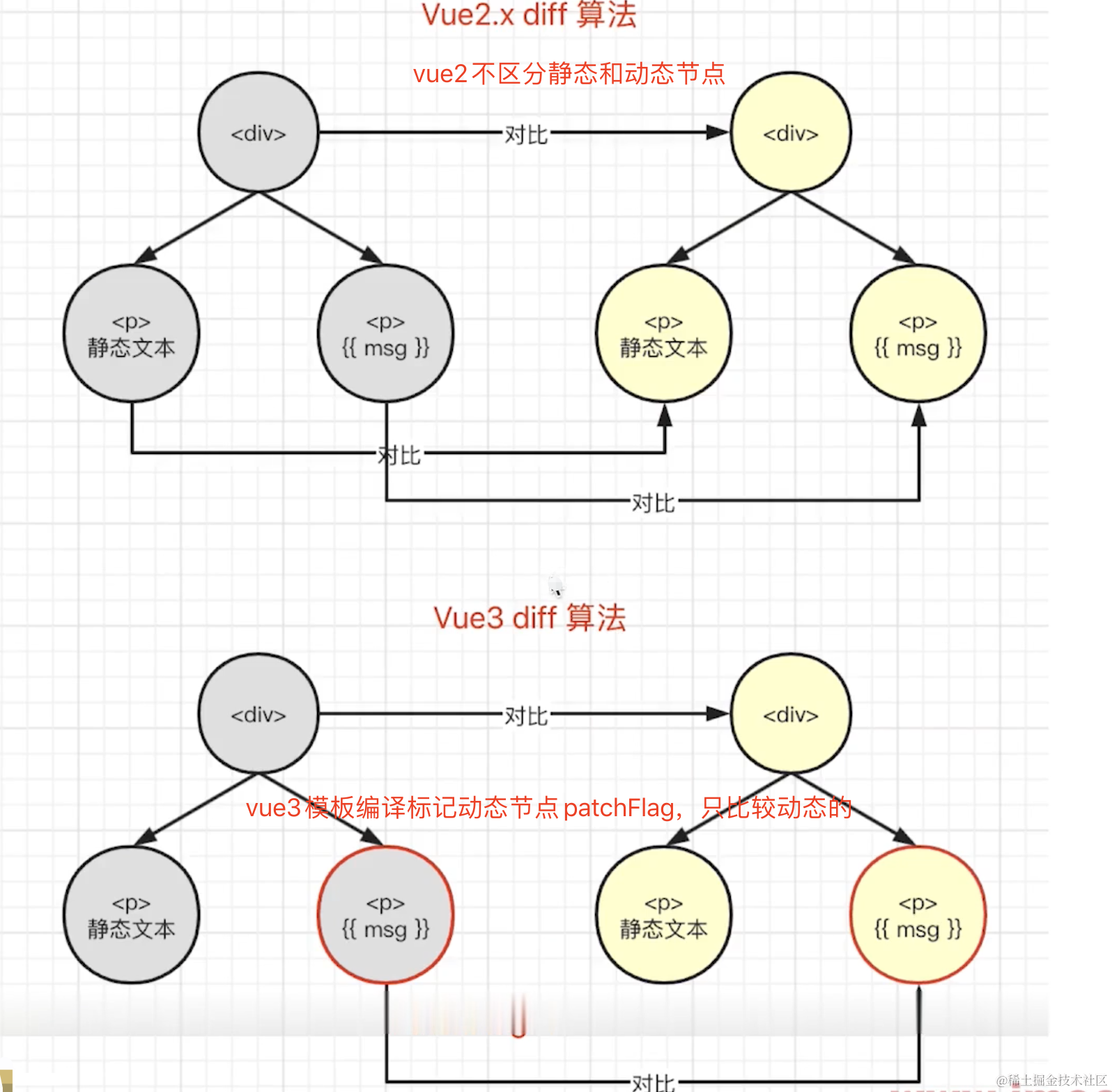
<!-- https://vue-next-template-explorer.netlify.app 中打开查看编译结果 -->
<div>
<span>hello vue3</span>
<span>{{msg}}</span>
<span :class="name">poetry</span>
<span :id="name">poetry</span>
<span :id="name">{{msg}}</span>
<span :id="name" :msg="msg">poetry</span>
</div>
// 编译后结果
import { createElementVNode as _createElementVNode, toDisplayString as _toDisplayString, normalizeClass as _normalizeClass, openBlock as _openBlock, createElementBlock as _createElementBlock } from "vue"
export function render(_ctx, _cache, $props, $setup, $data, $options) {
return (_openBlock(), _createElementBlock("div", null, [
_createElementVNode("span", null, "hello vue3"),
_createElementVNode("span", null, _toDisplayString(_ctx.msg), 1 /* TEXT */), // 文本标记1
_createElementVNode("span", {
class: _normalizeClass(_ctx.name)
}, "poetry", 2 /* CLASS */), // class标记2
_createElementVNode("span", { id: _ctx.name }, "poetry", 8 /* PROPS */, ["id"]), // 属性props标记8
_createElementVNode("span", { id: _ctx.name }, _toDisplayString(_ctx.msg), 9 /* TEXT, PROPS */, ["id"]), // 文本和属性组合标记9
_createElementVNode("span", {
id: _ctx.name,
msg: _ctx.msg
}, "poetry", 8 /* PROPS */, ["id", "msg"]) // 属性组合标记
]))
}
什么是HoistStatic和CacheHandler
HoistStatic
- 将静态节点的定义,提升到父作用域,缓存起来
- 多个相邻的静态节点,会被合并起来
- 典型的拿空间换时间的优化策略
<!-- https://vue-next-template-explorer.netlify.app 中打开查看编译结果:options开启hoistStatic -->
<div>
<span>hello vue3</span>
<span>hello vue3</span>
<span>hello vue3</span>
<span>{{msg}}</span>
</div>
// 编译结果
import { createElementVNode as _createElementVNode, toDisplayString as _toDisplayString, openBlock as _openBlock, createElementBlock as _createElementBlock } from "vue"
// 之后函数怎么执行,这些变量都不会被重复定义一遍
const _hoisted_1 = /*#__PURE__*/_createElementVNode("span", null, "hello vue3", -1 /* HOISTED */)
const _hoisted_2 = /*#__PURE__*/_createElementVNode("span", null, "hello vue3", -1 /* HOISTED */)
const _hoisted_3 = /*#__PURE__*/_createElementVNode("span", null, "hello vue3", -1 /* HOISTED */)
export function render(_ctx, _cache, $props, $setup, $data, $options) {
return (_openBlock(), _createElementBlock("div", null, [
_hoisted_1,
_hoisted_2,
_hoisted_3,
_createElementVNode("span", null, _toDisplayString(_ctx.msg), 1 /* TEXT */)
]))
}
<!-- https://vue-next-template-explorer.netlify.app 中打开查看编译结果:options开启hoistStatic -->
<!-- 当相同的节点达到一定阈值后会被vue3合并起来 -->
<div>
<span>hello vue3</span>
<span>hello vue3</span>
<span>hello vue3</span>
<span>hello vue3</span>
<span>hello vue3</span>
<span>hello vue3</span>
<span>hello vue3</span>
<span>hello vue3</span>
<span>hello vue3</span>
<span>hello vue3</span>
<span>{{msg}}</span>
</div>
// 编译之后
import { createElementVNode as _createElementVNode, toDisplayString as _toDisplayString, createStaticVNode as _createStaticVNode, openBlock as _openBlock, createElementBlock as _createElementBlock } from "vue"
// 多个相邻的静态节点,会被合并起来
const _hoisted_1 = /*#__PURE__*/_createStaticVNode("<span>hello vue3</span><span>hello vue3</span><span>hello vue3</span><span>hello vue3</span><span>hello vue3</span><span>hello vue3</span><span>hello vue3</span><span>hello vue3</span><span>hello vue3</span><span>hello vue3</span>", 10)
export function render(_ctx, _cache, $props, $setup, $data, $options) {
return (_openBlock(), _createElementBlock("div", null, [
_hoisted_1,
_createElementVNode("span", null, _toDisplayString(_ctx.msg), 1 /* TEXT */)
]))
}
CacheHandler 缓存事件
<!-- https://vue-next-template-explorer.netlify.app 中打开查看编译结果:options开启cacheHandler -->
<div>
<span @click="clickHandler">hello vue3</span>
</div>
// 编译之后
import { createElementVNode as _createElementVNode, openBlock as _openBlock, createElementBlock as _createElementBlock } from "vue"
export function render(_ctx, _cache, $props, $setup, $data, $options) {
return (_openBlock(), _createElementBlock("div", null, [
_createElementVNode("span", {
onClick: _cache[0] || (_cache[0] = (...args) => (_ctx.clickHandler && _ctx.clickHandler(...args)))
}, "hello vue3")
]))
}
SSR和Tree-shaking的优化
SSR优化
- 静态节点直接输出,绕过了
vdom - 动态节点,还是需要动态渲染
<!-- https://vue-next-template-explorer.netlify.app 中打开查看编译结果:options开启ssr -->
<div>
<span>hello vue3</span>
<span>hello vue3</span>
<span>hello vue3</span>
<span>{{msgs}}</span>
</div>
// 编译之后
import { mergeProps as _mergeProps } from "vue"
import { ssrRenderAttrs as _ssrRenderAttrs, ssrInterpolate as _ssrInterpolate } from "vue/server-renderer"
export function ssrRender(_ctx, _push, _parent, _attrs, $props, $setup, $data, $options) {
const _cssVars = { style: { color: _ctx.color }}
_push(`<div${
_ssrRenderAttrs(_mergeProps(_attrs, _cssVars))
}><span>hello vue3</span><span>hello vue3</span><span>hello vue3</span><span>${ // 静态节点直接输出
_ssrInterpolate(_ctx.msgs)
}</span></div>`)
}
Tree Shaking优化
编译时,根据不同的情况,引入不同的
API,不会全部引用
<!-- https://vue-next-template-explorer.netlify.app 中打开查看编译结果 -->
<div>
<span v-if="msg">hello vue3</span>
<input v-model="msg" />
</div>
// 编译之后
// 模板编译会根据模板写法 指令 插值以及用了特别的功能去动态的import相应的接口,需要什么就import什么,这就是tree shaking
import { openBlock as _openBlock, createElementBlock as _createElementBlock, createCommentVNode as _createCommentVNode, vModelText as _vModelText, createElementVNode as _createElementVNode, withDirectives as _withDirectives } from "vue"
export function render(_ctx, _cache, $props, $setup, $data, $options) {
return (_openBlock(), _createElementBlock("div", null, [
(_ctx.msg)
? (_openBlock(), _createElementBlock("span", { key: 0 }, "hello vue3"))
: _createCommentVNode("v-if", true),
_withDirectives(_createElementVNode("input", {
"onUpdate:modelValue": $event => ((_ctx.msg) = $event)
}, null, 8 /* PROPS */, ["onUpdate:modelValue"]), [
[_vModelText, _ctx.msg]
])
]))
}
Vite 为什么启动非常快
- 开发环境使用
Es6 Module,无需打包,非常快 - 生产环境使用
rollup,并不会快很多
ES Module 在浏览器中的应用
<p>基本演示</p>
<script type="module">
import add from './src/add.js'
const res = add(1, 2)
console.log('add res', res)
</script>
<script type="module">
import { add, multi } from './src/math.js'
console.log('add res', add(10, 20))
console.log('multi res', multi(10, 20))
</script>
<p>外链引用</p>
<script type="module" src="./src/index.js"></script>
<p>远程引用</p>
<script type="module">
import { createStore } from 'https://unpkg.com/redux@latest/es/redux.mjs' // es module规范mjs
console.log('createStore', createStore)
</script>
<p>动态引入</p>
<button id="btn1">load1</button>
<button id="btn2">load2</button>
<script type="module">
document.getElementById('btn1').addEventListener('click', async () => {
const add = await import('./src/add.js')
const res = add.default(1, 2)
console.log('add res', res)
})
document.getElementById('btn2').addEventListener('click', async () => {
const { add, multi } = await import('./src/math.js')
console.log('add res', add(10, 20))
console.log('multi res', multi(10, 20))
})
</script>
Composition API 和 React Hooks 的对比
- 前者
setup(相当于created、beforeCreate的合集)只会调用一次,而React Hooks函数在渲染过程中会被多次调用 Composition API无需使用useMemo、useCallback,因为setup只会调用一次,在setup闭包中缓存了变量Composition API无需顾虑调用顺序,而React Hooks需要保证hooks的顺序一致(比如不能放在循环、判断里面)Composition API的ref、reactive比useState难理解


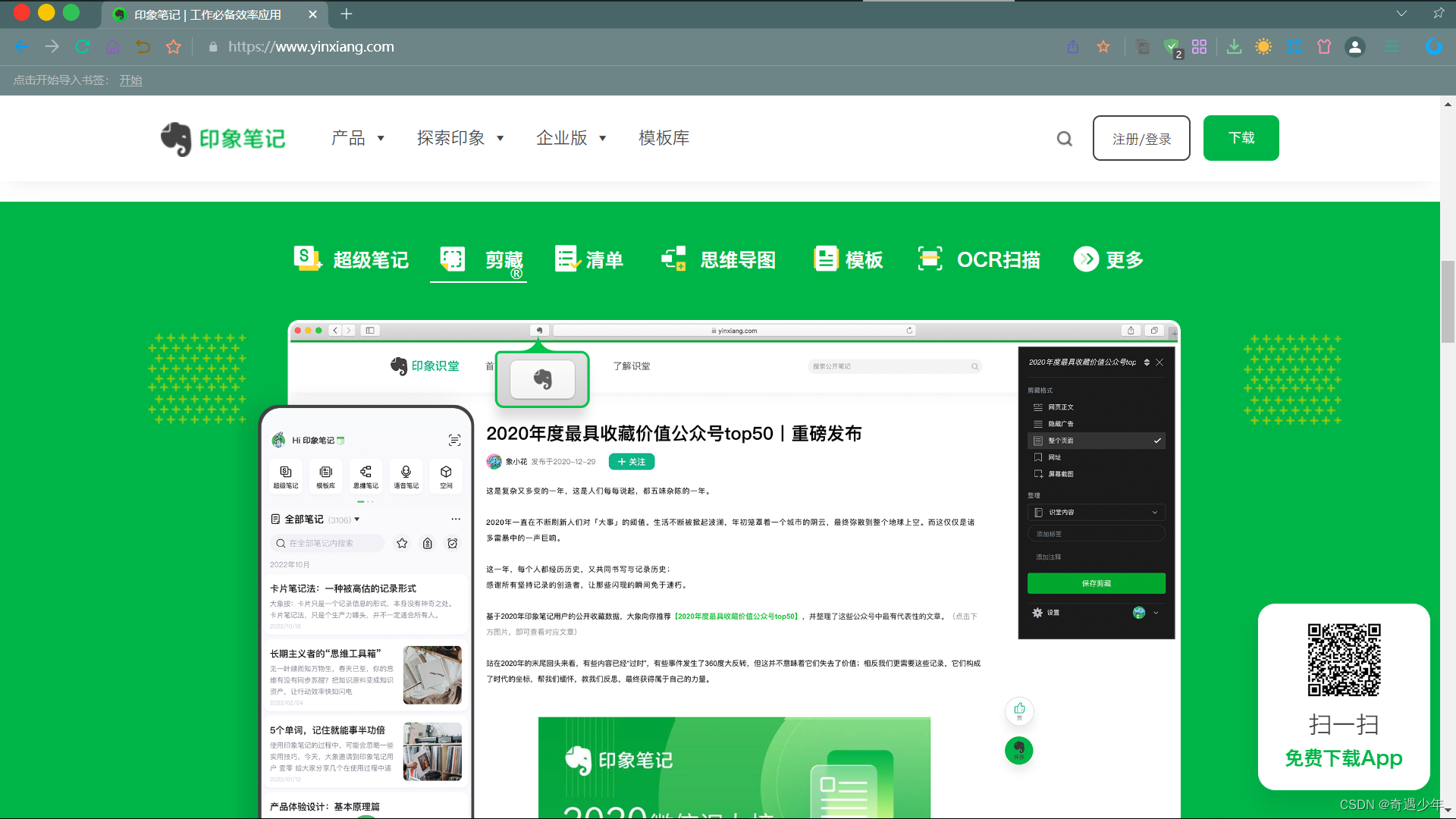
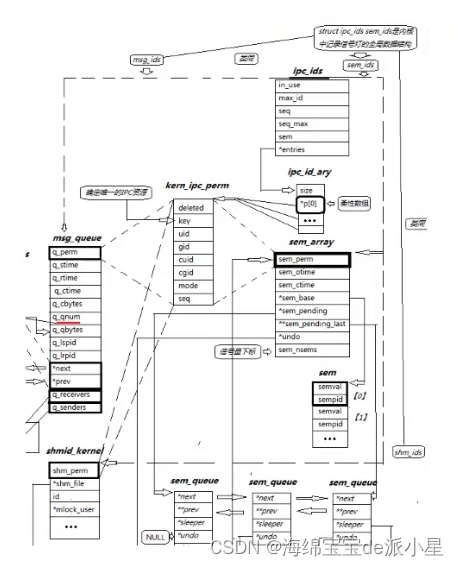






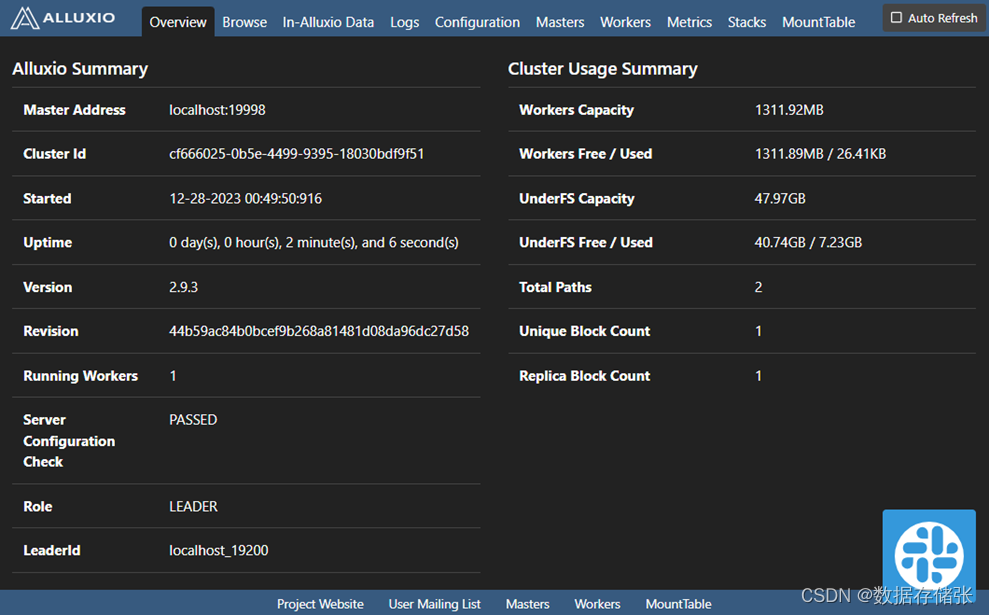
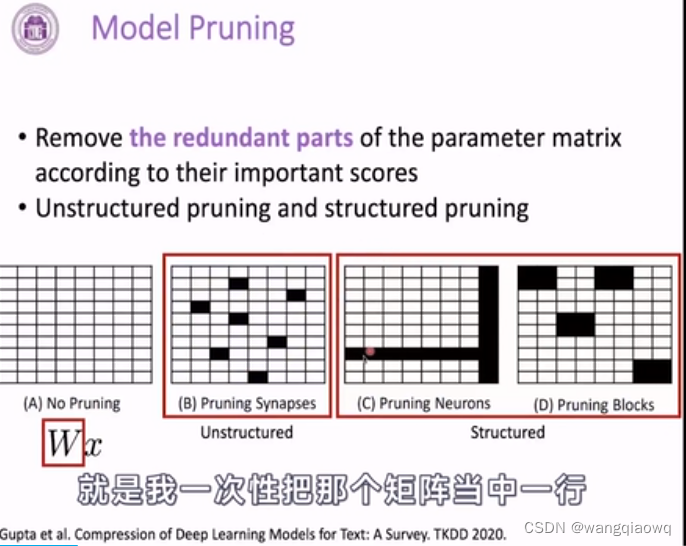



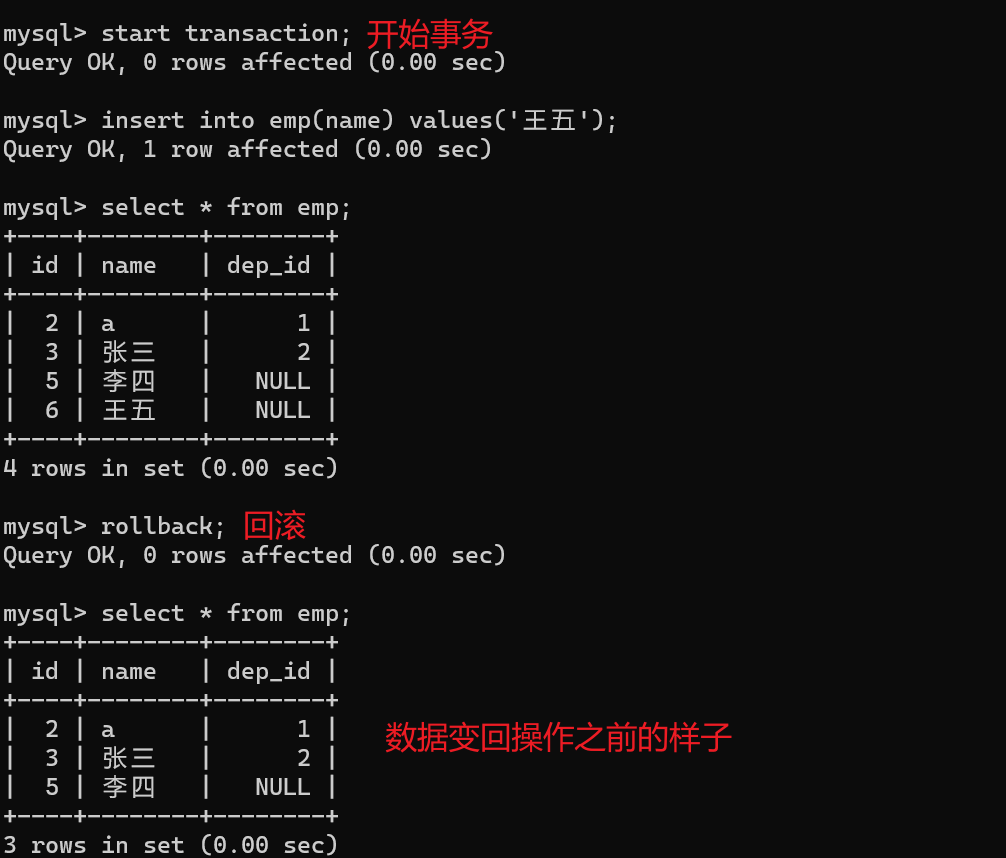
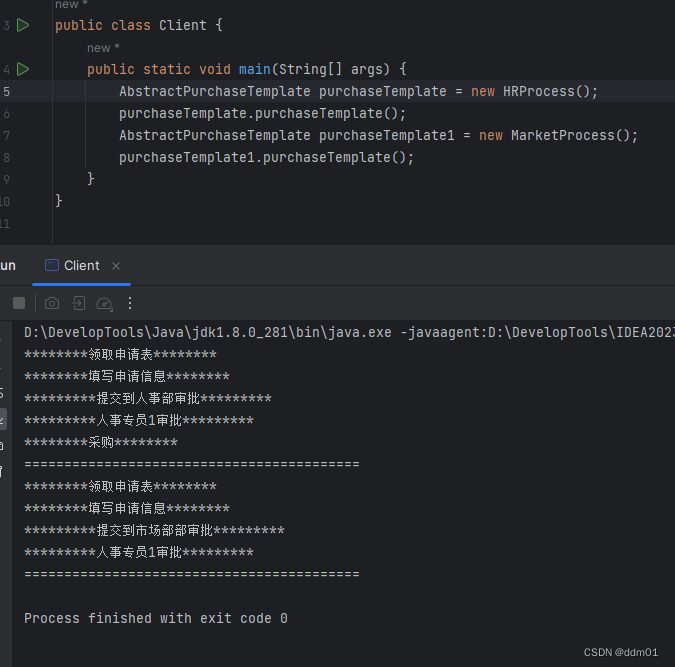
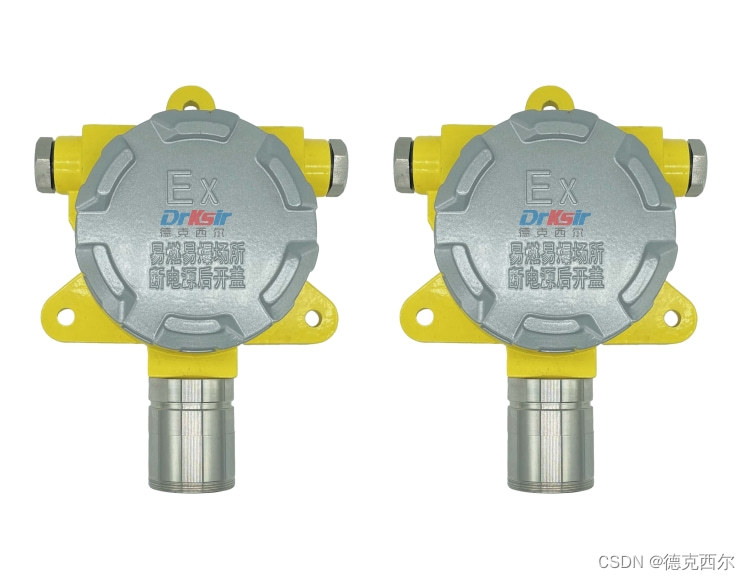

![[k8s系列]:kubernetes·概念入门](https://img-blog.csdnimg.cn/e34214888d2d44e8bccad59f0a36dfbb.png)